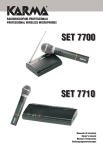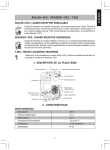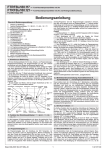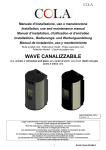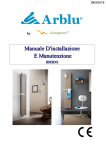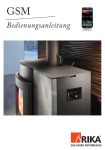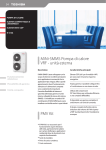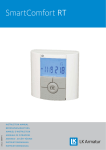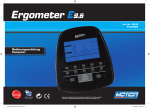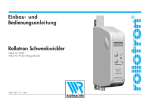Download 20110920_de_gb_fr_it Funk Raumsensor
Transcript
RIKA FUNK RAUMSENSOR Bedienungs- und Montageanleitung RIKA RADIO ROOM TEMPERATURE SENSOR Operating and assembly instructions CAPTEUR RADIO DE TEMPÉRATURE D´AMBIANCE RIKA Notice de fonctionnement et de montage SENSORE RADIO DI TEMPERATURA AMBIENTE RIKA Manuale 1 Seite 1 von 68 Deutsch Seite 2 English Page 19 Français Page 36 Italiano Pagina 53 Inhaltsverzeichnis Montageanleitung…………………………………………………………………. 3 RIKA Funk-Raumtemperaturfühler Öffnen und Erneuern der Batterien (Sender) .................................................. 6 Öffnen (Empfänger) ....................................................................................... 6 Erklärung und Funktion (Sender) ................................................................... 7 Erklärung und Funktion (Empfänger).............................................................. 8 Anschließen am Ofen..................................................................................... 9 Comfortfunktionen mit installiertem RIKA-Raumsensor für Pelletöfen mit Tastendisplay. ....................................................................... 10 Einstellungen .................................................................................................... 11 - Wochenschaltzeit....................................................................................... 12 - Tagesschaltzeit.......................................................................................... 13 Bedienung des Ofens im gewählten Heizbetrieb................................................ 14 „HEAT“ Modus ............................................................................................. 14 „ROOM“ Modus ........................................................................................... 15 „AUTO“ Modus............................................................................................. 16 Für Pelletöfen mit Touchdisplay. ....................................................................... 18 ACHTUNG: Das Design (die Optik) des Funkraumsensors kann Abweichungen zu den in der Anleitung abgebildeten Teilen aufweisen. Technische und optische Änderungen sowie Satz- und Druckfehler vorbehalten. 2 Montage des RIKA Funkraumtemperaturfühlers am Beispiel Pelletofen MEMO (Empfänger) unter der Rückwand. Die Montage des Empfängers an den Öfen COMO, PICO, REVO, MIRO, KAPO, ROCO u. INDUO unter- scheidet sich von den Abbildungen aufgrund der unterschiedlichen Aufnahmepositio- nen im Ofen. Die Bilder dazu finden Sie auf Seite 5. Achtung: Ihr Ofen muss ausgeschaltet und abgekühlt sein, ehe Tätigkeiten vorgenommen werden. Entsprechende Außerbetriebnahme des Gerätes aus den jeweiligen Betriebszuständen entnehmen Sie bitte aus Kapitel „Bedienung“. Die unten beschriebenen Tätigkeiten nur dann vornehmen, wenn der Netzstecker des Ofens aus der Steckdose gezogen ist. Vorbereitung: Zuerst wird die Rückwand des Pelletofen abgehoben und auf eine weiche Unterlage (Decke usw.) gelegt. Unterlage Empfänger D-Sub Stecker Bei der Demontage der Rückwand auf die Kabel achten! Als nächster Schritt die Rückwand für die Montage des Empfängers vorbereiten: Punkt 1. Bei dem untersten rechteckigen Ausschnitt alle Stege mit einem Eisensägeblatt durchtrennen. 3 Punkt 2. Mit einer kleinen Schlichtfeile die Stegreste vorsichtig abfeilen. Punkt 3. Anschließend wird das mitgelieferte Montageblech an den dafür vorgesehenen Stehbolzen mit vier Beilagscheiben und Muttern M4 befestigt. Es gibt hier unterschiedliche Befestigungsvarianten. Anstatt der Stehbolzen kann auch eine Montage mit SKSchraube und Einpressmutter vorkommen. Punkt 4. Nun wird das Kabel vom FunkraumtemperaturfühlerEmpfänger mit dem 15-poligen Stecker von innen durch die Öffnung nach außen geführt. Punkt 5. Der Empfänger wird wie abgebildet in der Halterung eingeklemmt. Punkt 6. Nun wird der Stecker an der am oberen Ende befindlichen D-Sub Kupplung angeschlossen und mit einem Schraubendreher gesichert. 4 Wenn alle Punkte ausgeführt wurden, kann die Rückwand wieder am Pelletofen eingehängt werden. Zum Einstellen der Ofensoftware, gehen Sie wie in der Bedienungsanleitung beschrieben vor. Montagebilder TOPO Montagebilder COMO, PICO, REVO, MIRO, KAPO, ROCO u. INDUO 1. Seitenwand (displayseitig) abschrauben 1. Rückwand-Deckel abschrauben 2. Montageblech befestigen (Die Bilder zur Demontage der Seitenverkleidung entnehmen Sie bitte der jeweiligen Bienungsanleitung.) Bitte auf Display- und Erdungskabel achten! 2. Montageblech befestigen 3. Rückwand ausschneiden nur bei Type: Como, Revo, Pico Miro u. Induo erforderlich! 4. 5. Empfänger montieren und anschließen 3. 4. nur für Type Roco u. Kapo 5 Empfänger montieren und anschließen Öffnen und Erneuern der Batterien im RIKA Funk-Raumtemperaturfühler (Sender) Öffnen des RIKA FunkRaumtemperaturfühler (Empfänger) Öffnen: Öffnen: Mit einem kleinen Schraubendreher oder mit einem dafür geeigneten Werkzeug die beiden Kunststoffnasen nach innen drücken und die zwei Hälften vorsichtig auseinander ziehen. Die beiden Teile des Empfängers vorsichtig auseinander ziehen. Erneuern der Batterien: Es sollten unbedingt Long Life Batterien verwendet werden! (Panasonic Industrial Alkaline oder Varta Alkali Mangan) Achten Sie beim Einsetzen der neuen Batterien auf die Übereinstimmung des Plus und Minuspols. Das Einstellen des DIP- Schalters ist auf Seite 8 beschrieben. 6 Erklärung und Funktion des RIKA Funk-Raumtemperaturfühler (Sender) Erklärung: DIP-Schalter: Die kleinen DIP-Schalter von 1-3 dienen zur Festlegung der Adressen. Die Position der Schalter 1-3 am Sender muss mit der Position der Schalter 1-3 am Empfänger übereinstimmen. Sind zwei Sender mit der gleichen Adresse im Empfangsbereich, blinkt die LED Anzeige am Empfänger abwechselnd grün und rot. Nach Beheben des Adressenfehlers geht die Anzeige in den Normalmodus über. (LED leuchtet grün.) DIP-Schalter Nr. 4 erhöht die Senderleistung. - Stellung OFF 1 mW. - Stellung ON 10 mW. Die Stellung On für DIP-Schalter Nr. 4 verwendet man, wenn die Entfernung vom Sender zum Empfänger zu groß ist, oder ein Hindernis (z.B. eine Wand) das Empfangsignal beeinflusst und die Leistung von 1 mW nicht mehr ausreicht. 7 Erklärung und Funktion des RIKA Funk-Raumtemperaturfühler (Empfänger) löscht. Bei Öfen mit Touch-Display wird die Fehlermeldung mit der „EnterTaste“quittiert. Wird der Empfänger mit dem Ofen verbunden, (im stromfreien Zustand) so blinkt die LED Anzeige nach dem Anschließen ans Stromnetz grün. Der Ofen kann nun wieder in Betrieb genommen werden. Tritt die Fehlermeldung sofort nach dem Quittieren erneut auf, ist entweder die Batterie im Sendeteil leer oder der Funkraumsensor defekt. Die Standardeinstellung kann beibehalten werden. Die DIP-Schalter müssen nur in Sonderfällen modifiziert werden. Spätestens nach 35 Sekunden muss die Verbindung erkannt werden. Falls nach einer Minute noch immer keine Verbindung hergestellt ist, muss ein Fehler vorliegen: Falsche DIP-Schalter-Einstellung, leere Batterie, zu großer Abstand (Sender – Empfänger) oder stark störende Umgebung. Achtung ! DIP-Schalter Nr. 4 zur Erhöhung der Senderleistung in ON Position nur am Sender aktiv. DIP- Schalter Nr. 4 am Empfänger auf ON dient zur Testausgabe, (Fix 25°C.) und muss für einen geregelten Heizbetrieb auf OFF Position zurückgestellt werden. Achtung: Durch lokale Funknetze (z.B. WLAN) können die Frequenzbereiche überlappen und zu Störungen auch während des Heizbetriebes führen. Wird die Übertragung zwischen Sender und Empfänger über eine längere Zeit gestört und kein Signal empfangen, so wird diese mit „ROOM SENSOR SIGNAL LOST” bzw. “RAUMFÜHLER KEINE VERBINDUNG” – bei Geräten mit TouchDisplay, angezeigt und der Ofen geht in den Abschalt- Zustand. Mit der ON/OFF Taste (solange gedrückt halten bis die Anzeige „ROOM SENSOR SIGNAL LOST“ erlischt) wird die Fehlermeldung bei Öfen mit TastenDisplay ge- DIP- Schalter 1-3 Adresse, muss mit DIP- Schalter 1-3 am Sender übereinstimmen. Die Farbe der LED Anzeige hängt von der Batteriespannung ab: Voll .................... grün Fast leer ............ orange Leer ................... rot 8 Anschließen des RIKA Funk-Raumtemperaturfühler am Ofen Stecken Sie den Empfängerteil des RIKA Funk-Raumtemperaturfühlers an der dafür vorgesehenen D-Sub Kupplung an. (Anschließen des RIKA Raumtemperaturfühlers nur im stromlosen Zustand des Ofens.) Den D-Sub Stecker mit einem passenden Schraubendreher befestigen. Der Ofen kann nun ans Netz angeschlossen werden. 9 Pelletöfen mit Tastendisplay Comfortfunktionen mit installiertem RIKA-Raumsensor Wechseln Sie zuerst von EASY auf HEAT. Drücken Sie dazu die Menütaste solange, bis die Anzeige HEAT am Display erscheint. nicht mehr Sie selbst bestimmen, dies übernimmt abhängig von der im Raum vorherrschenden Temperatur das RIKARaumthermostat für Sie. Vorraussetzung für zusätzliche Comfortfunktionen ist die Installation des optional erhältlichen RIKA-Raumsensors. Hier können Sie zwischen drei möglichen Betriebsarten (Modi) wählen: - AUTO (Heizbetrieb in Kombination von Raumsensor und Zeitprogramm) Im „AUTO“ Modus haben Sie nun noch zusätzlich die Möglichkeit, die eingestellte Wohlfühltemperatur zu zwei voreingestellten Tages- bzw. Wochenzeiten automatisch abzurufen. In den Zeiträumen zwischen den Heizzeiten wird eine von Ihnen einstellbare Absenktemperatur eingehalten. - HEAT (manueller Heizbetrieb) Dieser Modus entspricht dem Ihnen bereits aus dem einfachen Heizbetrieb bekannten „EASY“ Modus, in diesem kann lediglich die Heizleistung des Ofens in 5er-Schritten gesteigert oder gesenkt werden. Die Heizleistung wird, ebenso wie im "ROOM" Modus von der elektronischen Steuerung vorgegeben. - ROOM (Heizbetrieb mit Raumsensor) Im „ROOM“ Modus wird die Heizleistung von der elektronischen Steuerung vorgegeben und kann nicht verändert werden. Ob der Ofen jedoch heizt, müssen Taste blättern Taste Anzeige ändern MODE I/O (+)/(-) I/O MENU HEAT ROOM AUTO ROOM AUTO HEAT MODE Die Wahl der gewünschten Betriebsart treffen Sie im Menüpunkt „Mode“. Beschreibung Anzeige zum Eintritt in die Auswahlebene für den Modus des Heizbetriebes Anzeige des bisher eingestellten Heizbetriebes (HEAT, ROOM oder AUTO) Durch ein bzw. mehrmaliges Drücken der (+) bzw. (-) Taste treffen sie die Auswahl des Heizbetriebes. (HEAT, ROOM oder AUTO) Hiermit wird der ausgewählte Heizbetrieb gespeichert. Durch ein bzw. mehrmaliges Drücken der MENU Taste gelangen Sie zurück in die Standardanzeige 10 Einstellungen „AUTO“ Modus Um Ihren Ofen im AUTO Modus betreiben zu können, müssen Sie die Zeitprogrammierung vornehmen. - Einstellung des aktuellen Datums und der Tageszeit Die Einstellungen bezüglich Datum und Zeit nehmen Sie im Menü TIME vor. Taste Taste Anzeige blättern ändern TIME I/O TIME SET I/O 10:02 + 11:02 11:03 MENU DAY 01 (+)/(-) DAY 31 MENU MONTH 02 (+)/(-) MONTH 06 MENU YEAR 06 (+)/(-) YEAR 07 MENU MO I/O Menu MENU TIME SET TIME SET Beschreibung Anzeige zum Eintritt in die Zeitprogrammierung Anzeige zum Eintritt in die Zeitprogrammierung des aktuellen Datums und der Tageszeit Anzeige der Stunden und Minuten Änderung der Stunden Änderung der Minuten Anzeige des Datums (Tag) Durch ein bzw. mehrmaliges Drücken der (+) bzw. (-) Taste können Sie den aktuellen Tag einstellen. Anzeige des Datums (Monat). Durch ein bzw. mehrmaliges Drücken der (+) bzw. (-) Taste können Sie den aktuellen Monat einstellen. Anzeige des Datums (Jahr). Durch ein bzw. mehrmaliges Drücken der (+) bzw. (-) Taste können Sie das aktuelle Jahr einstellen. Zur Kontrolle wird Ihnen nun der aktuelle Wochentag angezeigt. Sollte dieser nicht korrekt sein, ist Ihnen bei der Datumseingabe ein Fehler unterlaufen. War der angezeigte Wochentag korrekt, bestätigen Sie die Datumseingabe mit der I/O Taste. War der angezeigte Wochentag jedoch nicht korrekt, wird durch Drücken der Taste MENU das Datum auf den zuletzt gespeicherten Wert zurückgesetzt. Nun muss das Datum noch einmal neu eingegeben werden. Durch ein bzw. mehrmaliges Drücken der MENU Taste gelangen Sie zurück in die Standardanzeige 11 - Einstellung der Tages- bzw. Wochenschaltzeiten Die Einstellungen bezüglich Schaltzeiten nehmen Sie im Menü TIME vor. - Wochenschaltzeit Hier ist es Ihnen nun möglich, zwei für jeden Tag der Woche gleich geltende Schaltzeiten zu hinterlegen. Werksseitig sind bereits Schaltzeiten hinterlegt, diese können jedoch beliebig durch Drücken der (+)/(-) Taste verändert werden. Taste Taste Anzeige blättern ändern TIME I/O TIME SET MENU TIME AUTO I/O DAY (-) WEEK I/O ON1 6:00 MENU OFF1 12:00 MENU ON2 14:00 MENU OFF2 18:00 MENU WEEK MENU TIME AUTO Beschreibung Anzeige zum Eintritt in die Zeitprogrammierung Anzeige zum Eintritt in die Zeitprogrammierung des aktuellen Datums und der Tageszeit Anzeige zum Eintritt in die Schaltzeitprogrammierung. Durch Drücken der (+) Taste zurück zu DAY Anzeige der ersten Startzeit Anzeige - Ende der ersten Schaltzeit Anzeige der zweiten Startzeit Anzeige - Ende der zweiten Schaltzeit Anzeige zum Eintritt in das Wochenschaltzeitprogramm Durch Drücken der MENU Taste gelangen Sie zurück in die Standardanzeige Die Programmierung der Wochenschaltzeit wird automatisch in die Tagesschaltzeitprogrammierung übernommen. Achten Sie bitte beim Einprogrammieren der Schaltzeiten darauf, dass es zu keinen Überschneidungen der Heizzeiten kommt. 12 - Tagesschaltzeit Hier ist es Ihnen nun möglich, für jeden Tag der Woche je zwei eigene Schaltzeiten zu hinterlegen. Die eingegebene Tagesschaltzeit überregelt dann an diesem Tag die Wochenprogrammierung. Werksseitig sind bereits Schaltzeiten hinterlegt, diese können jedoch beliebig durch Drücken der (+)/(-) Taste verändert werden. Taste Taste Anzeige blättern ändern TIME I/O TIME SET MENU TIME AUTO I/O DAY I/O MO I/O ON1 6:00 MENU OFF1 12:00 MENU ON2 14:00 MENU OFF2 18:00 MENU MO MENU TU Beschreibung Anzeige zum Eintritt in die Zeitprogrammierung Anzeige zum Eintritt in die Zeitprogrammierung des aktuellen Datums und der Tageszeit Anzeige zum Eintritt in die Schaltzeitprogrammierung. Anzeige zum Eintritt in das Tagesschaltzeitprogramm Anzeige für den ersten Tag der Woche (Monday) Anzeige der ersten Startzeit Anzeige - Ende der ersten Schaltzeit Anzeige der zweiten Startzeit Anzeige - Ende der zweiten Schaltzeit Anzeige für den ersten Tag der Woche (Monday) Anzeige für den zweiten Tag der Woche (Tuesday) Gehen Sie für jeden weiteren Wochentag in gleicher Weise vor bis SU (Sunday bzw. Sonntag). MENU SU MENU MENU DAY TIME AUTO Anzeige zur Bestätigung der Programmierung des letzten Tages der Woche Anzeige zum Eintritt in das Tagesschaltzeitprogramm Durch Drücken der MENU Taste gelangen Sie zurück in die Standardanzeige 13 Bedienung des Ofens im gewählten Heizbetrieb „HEAT“ Modus - Gerät: ausgeschaltet Taste Anzeige HEAT OFF + - HEAT 45 HEAT 35 Beschreibung Standardanzeige für ein ausgeschaltetes Gerät im „HEAT“ Modus. Hier kann auch bei ausgeschaltetem Gerät die Leistung zwischen Einstellung 30 (minimale Leistung) und 100 (Nennwärmeleistung) auf und ab reguliert werden. Durch Drücken der (+) Taste Steigerung der Leistung in 5erSchritten. (auf z.B. 35, 40, 45, usw.) Durch Drücken der (-) Taste Senkung der Leistung in 5erSchritten. - Gerät: starten Taste Anzeige I/O IGNIT START HEAT Beschreibung Durch Drücken der I/O Taste startet das Gerät. Dies wird Ihnen durch „IGNIT“ (Zündung) angezeigt, diese Anzeige wird nach erfolgter Zündung durch START abgelöst. Nach Beendigung der Startphase erscheint im Display HEAT mit Leistungsangabe. Startvorgang abbrechen: Innerhalb der ersten Minute können Sie die IGNIT-Phase abbrechen, in dem Sie die I/O-Taste so lange gedrückt halten, bis die Anzeige IGNIT OFF erscheint. Nach dem Loslassen folgt die Anzeige HEAT OFF. Wird der Startvorgang erst nach einer Minute unterbrochen, läuft das Startprogramm fertig ab, am Display wird jedoch bereits HEAT OFF angezeigt. Gilt für alle Modi (HEAT, AUTO und ROOM). - Gerät: eingeschaltet Taste Anzeige HEAT 40 + HEAT 45 HEAT 40 Beschreibung Standardanzeige für ein eingeschaltetes Gerät, im „HEAT“ Modus Durch Drücken der (+) Taste Steigerung der Leistung in 5erSchritten. Durch Drücken der (-) Taste Senkung der Leistung in 5erSchritten. 14 „ROOM“ Modus - Gerät: ausgeschaltet Taste Anzeige ROOM OFF + - ROOM 25 ROOM 23 Beschreibung Standardanzeige für ein ausgeschaltetes Gerät im „ROOM“ Modus. Hier kann auch bei ausgeschaltetem Gerät die gewünschte Raumtemperatur im Bereich von 5-28°C verstellt werden. Durch Drücken der (+) Taste Steigerung der Temperatur um 1°C. Durch Drücken der (-) Taste Senkung der Temperatur um 1°C. - Gerät: starten Taste Anzeige I/O IGNIT START ROOM Beschreibung Durch Drücken der I/O Taste startet das Gerät sofern die gewünschte Raumtemperatur noch nicht erreicht ist. Dies wird Ihnen durch „IGNIT“ (Zündung) angezeigt, diese Anzeige wird nach erfolgter Zündung durch START abgelöst. Nach Beendigung der Startphase erscheint im Display ROOM mit der von Ihnen gewünschten Raumtemperatur. - Gerät: eingeschaltet Taste Anzeige ROOM 23 + ROOM 24 ROOM 22 Beschreibung Standardanzeige für ein eingeschaltetes Gerät, im „ROOM“ Modus Durch Drücken der (+) Taste Steigerung der Temperatur um 1°C. Durch Drücken der (-) Taste Senkung der Temperatur um 1°C. - Gerät: automatisch stoppen Taste Anzeige STOP STANDBY Beschreibung Durch Erreichen der gewünschten Raumtemperatur stoppt das Gerät automatisch und geht in die STANDBY (Bereitschaftsmodus) Stellung. Sobald die gewünschte Temperatur wieder unterschritten wird startet das Gerät erneut. - Gerät: stoppen durch Drücken der I/O Taste Taste Anzeige I/O STOP ROOM OFF Beschreibung Durch Drücken der I/O Taste erscheint kurz die Anzeige STOP und wechselt danach auf ROOM OFF. Für einen neuerlichen Start muss die I/O Taste gedrückt werden. 15 „AUTO“ Modus - Gerät: ausgeschaltet Raumtemperatureinstellung innerhalb der Schaltzeit Taste blättern Taste Anzeige ändern AUTO OFF + I/O + I/O On – T 25 On – T 25 On – T 26 On – T 24 AUTO OFF Beschreibung Standardanzeige für ein ausgeschaltetes Gerät im „AUTO“ Modus. Hier kann auch bei ausgeschaltetem Gerät die gewünschte Raumtemperatur von 10-28°C eingestellt werden. Mit der Plus(+)-Taste erscheint die Anzeige zum Eintritt in die Raumtemperaturregelung. Damit die gewünschte Raumtemperatur eingestellt werden kann, muss die I/O Taste gedrückt werden. Durch Drücken der (+) Taste Steigerung der Temperatur um 1°C. Durch Drücken der (-) Taste Senkung der Temperatur um 1°C. Hiermit wird die gewählte Raumtemperatur gespeichert. Absenktemperatureinstellung zwischen den Schaltzeiten Taste blättern Taste Anzeige ändern AUTO OFF I/O + I/O Off – T 20 Off – T 20 Off – T 21 Off – T 19 AUTO OFF Beschreibung Standardanzeige für ein ausgeschaltetes Gerät im „AUTO“ Modus. Hier kann auch bei ausgeschaltetem Gerät die gewünschte Absenktemperatur im Bereich von 520°C eingestellt werden. Mit der Minus(-)-Taste erscheint die Anzeige zum Eintritt in die Absenktemperatur. Damit die gewünschte Absenktemperatur eingestellt werden kann, muss die I/O Taste gedrückt werden. Durch Drücken der (+) Taste Steigerung der Temperatur um 1°C. Durch Drücken der (-) Taste Senkung der Temperatur um 1°C. Hiermit wird die gewählte Absenktemperatur gespeichert. 16 - Gerät: starten Taste Anzeige I/O IGNIT START AUTO Beschreibung Durch Drücken der I/O Taste startet das Gerät sofern die gewünschte Raumtemperatur noch nicht erreicht ist und das Gerät sich in einer aktuellen Schaltzeit befindet. Dies wird Ihnen durch „IGNIT“ (Zündung) angezeigt, diese Anzeige wird nach erfolgter Zündung durch START abgelöst. Nach Beendigung der Startphase erscheint im Display AUTO mit der von Ihnen gewünschten Raumtemperatur. - Gerät: eingeschaltet Raumtemperatur- und Absenktemperatureinstellung erfolgt wie bei ausgeschaltetem Gerät beschrieben. - Gerät: automatisch stoppen Taste Anzeige STOP STANDBY Beschreibung Durch Erreichen der gewünschten Raumtemperatur bzw. dem Ende der programmierten Schaltzeit, stoppt das Gerät automatisch und geht in die STANDBY (Bereitschaftsmodus) Stellung. Sobald die gewünschte Temperatur wieder unterschritten wird oder eine neue Schaltzeit beginnt, startet das Gerät erneut. - Gerät: stoppen durch Drücken der I/O-Taste Taste Anzeige I/O STOP AUTO OFF Beschreibung Durch Drücken der I/O-Taste erscheint kurz die Anzeige STOP und wechselt danach auf AUTO OFF. Bitte um Beachtung: Das Gerät startet nun nicht wieder automatisch, es muss wiederum durch Drücken der I/O-Taste gestartet werden. 17 Pelletofen mit Touchdisplay Komfortmodus Zusätzlich zur Raumptemperatur können im Komfort-Modus auch Heizzeiten genutzt werden. Dabei müssen im Menü "Einstellungen" die Heizzeiten auf "EIN" gestellt werden. Die Programmierung der Heizzeiten entnehmen Sie bitte der Ofenbedienungsanleitung. Der Komfort-Modus kann nur mit einem angeschlossenen Raumsensor angewählt (aktiviert) werden. Nach Anschluss des Raumsensors wird der Komfort-Modus farblich hervorgehoben und am Bildschirmrand rechts das Thermometer hell angezeigt. Durch Drücken der Komfort-ModusTaste wird anstatt der Heizleistung in Prozenten die Temperatur in C° zur Auswahl angezeigt. 18 Contents Assembly instructions ....................................................................................... 20 RIKA radio room temperature sensor Open the sensor and fit new batteries (transmitter)............................................ 23 Open the sensor (receiver)............................................................................... 23 Explanation and functioning (transmitter) .......................................................... 24 Explanation and functioning (receiver) .............................................................. 25 Connection of the sensor to the stove ............................................................... 26 Comfort functions with installed RIKA room sensor Pellet stove with buttons display ............................................................................. 27 Settings................................................................................................................... 28 - Weekly switching time ........................................................................... 29 - Daily switching time ............................................................................... 30 Operation of the stove in selected heating operation .......................................... 31 “HEAT” mode................................................................................................. 31 „ROOM“ mode ............................................................................................... 32 “AUTO” mode ................................................................................................ 33 Pellet stove with touch screen ................................................................................... 35 NOTE: The design (visual appearance) of the wireless room sensor can deviate from the parts shown in the instructions. We reserve the right to make technical and optical changes and take no responsibility for any setting and printing errors. 19 Assembly of the RIKA room temperature sensor demonstrated by the example of the pellet stove MEMO (Receiver) behind rear panel. The assembly of the receiver for the stoves COMO, PICO, REVO, MIRO, KAPO, ROCO u. INDUO distin- guishes itself from the illustrations in that the receptive positions within the stove are different. You can find the corresponding pictures on page 21. Caution: Your stove must be switched off and cooled down before any work is carried out. Information about switching the device out of the respective operating condition can be found in “Operation”. Before carrying out the work below ensure that the mains plug of the stove is removed from the mains socket. Preparation: First remove the rear panel of the stove and place on a soft underlay (cover, etc.). Underlay Receiver D sub-connector Take care of the cable when removing the rear panel! Then prepare the rear panel for the installation of the receiver: Step 1. Using a hacksaw remove the tabs of the lower rectangular cut-out. 20 Step 2. Carefully file off the residue with a small flat file. Step 3. Finally attach the supplied mounting plate to the pillar bolts using four M4 nuts and washers. Different kinds of fixation are possible here. Instead of using studs, an assembly with hex screws and press nuts is also possible. Step 4. Now feed the cable of the radio room temperature sensor receiver with the 15 pin plug from the inside through the opening to the outside. Step 5. The receiver is pressed into the holder as shown in the photograph. Step 6. Now connect the plug to the D sub-socket on the upper part of the panel and tighten using a screwdriver. 21 When all steps have been carried out the rear panel can be re-fitted to the pellet stove. To adjust the stove software proceed as described in the operating instructions. Assembly pictures COMO, REVO, PICO, MIRO and INDUO 1. Unscrew side panel (Please find Assembly pictures TOPO 1. Unscrew rear panel plate 2. Fix assembly plate the pictures for dismantling from the operating manual.) Please pay attention to the display and grounding cable! 2. Fix assembly plate 3. Cut out rear panel Como, Revo, Pico, Miro, Induo 4. Mount and connect receiver 3. 4. 5. Roco, Kapo 22 Mount and connect receiver Open the RIKA radio room temperature sensor and fit new batteries (transmitter) Open the RIKA radio room temperature sensor (receiver) Open: Open: Using a small screwdriver or a suitable tool press the two plastic tabs inwards and carefully pull the two halves apart. Carefully pull the two sections of the receiver apart. Fit new batteries: Long Life batteries must be used! (Panasonic Industrial Alkaline or Varta Alkali Mangan) Ensure the new batteries are fitted with the correct polarity (+ and -). Setting of the DIP switch is described on page 25. 23 Explanation and functioning of the RIKA radio room temperature sensor (transmitter) Explanation: DIP switch: The small DIP-switches 1-3 are used to set the addresses. The position of switches 1- 3 on the transmitter must match the position of switches 1-3 on the receiver. If there are two transmitters with the same address in the receive area, the LED indicator on the receiver flashes green and red alternately. After removal of the address error the indicator changes to normal mode (LED illuminates green.) DIP switch No. 4 increases the transmitter output. - 24 Position Off 1 mW. Position On 10 mW. The On setting for DIP switch No. 4 is used, if the distance from the transmitter to the receiver is too great, or a barrier (e.g. a wall) affects the receive signal and the output of 1 mW is no longer sufficient. Explanation and functioning of the RIKA radio room temperature sensor (receiver) SENSOR SIGNAL LOST" disap- pears). For stoves with touch display the If the receiver is connected to the stove (with power off) the LED indicator flashes green on connection of mains power. error message is acknowledged by pressing the "Enter" key. You can now resume opera- tion of the stove. If the same message appears again immediately after acknowledging the error, it means that either the battery in the transmitter is flat or the wireless room sensor is faulty. The connection must be detected after 35 seconds at the most. If no connection has been made after one minute, an error has occurred: Incorrect DIP switch setting, discharged batteries, distance too great (transmitter – receiver) or strong interference in the vicinity. The standard setting can be retained. The DIP switch only has to be changed in special circumstances. Note: Local wireless networks (e.g. WLAN) can cause frequency ranges to overlap and result in malfunctions, even during a heating procedure. If transmission between the transmitter and receiver is disrupted for a prolonged period and no signal is received, this will be indicated by the message "ROOM SENSOR SIGNAL LOST" appearing in the display and the stove will then shut down. The error message can be deleted by pressing the ON/OFF button (press and hold until the message "ROOM Caution! DIP switch No. 4 for increasing the transmitter output in ON position only active on the transmitter. The ON setting of DIP switch no. 4 on the receiver is used for the test output (fixed 25°C) and must be reset to the OFF setting for a regulated heating operation. 25 DIP switch 1-3 address, must match DIP- switch 1-3 on the transmitter. The colour of the LED depends on the battery voltage: Fully charged................... green Partially discharged ......... orange Discharged ...................... red Connection of the RIKA radio room temperature sensor to the stove Connect the receiver section of the RIKA radio room temperature sensor to the D sub-coupling provided. (Ensure the current is switched off when connecting the RIKA room temperature sensor to the stove.) Use a suitable screwdriver to attach the D sub plug. The stove can now be connected to the mains power. 26 Pellet stove with buttons display Comfort functions with installed RIKA room sensor Change from EASY to HEAT. Keep pressing the Menu button until HEAT appears in the display. You do not need to worry about whether the stove heats up or not, the RIKA room thermostat takes care of this depending on the prevailing temperature in the room. A pre-condition for additional comfort functions is the installation of the optional RIKA room sensor. You can choose between three possible operating modes: - AUTO (Heating operation with room sensor and time program combined) In “AUTO” mode you have the additional possibility of calling up the set comfort temperature for two pre-set days or weeks automatically. In the time periods between the heating times a low temperature that you set is maintained. - HEAT (Manual heating operation) This mode corresponds to the EASY mode that you already know from basic operation, in which the heat output of the stove can only be increased or decreased in steps of five units. The heat output of the stove is regulated by the electronic control (such as in "ROOM" in the menu). - ROOM (Heating operation with room sensor In “ROOM” mode the heat output of the stove can not be changed and is regulated by the electronic control. Move through keys Change Indicator key MODE I/O (+)/(-) I/O MENU HEAT ROOM AUTO ROOM AUTO HEAT MODE Selection of the required operating mode is found in “Mode” in the menu. Description Indication of entry to the selection level for the heating operation mode. Indication of current heating operation. (HEAT, ROOM or AUTO) By pressing the (+) or (-) keys repeatedly you can select the heating operation. (HEAT, ROOM or AUTO) This saves the selected heating operation. By pressing the MENU key once or repeatedly you return to the standard indication. 27 Settings „AUTO“ mode settings To operate your oven in the AUTO mode you must program it. Setting of the current date and time. The settings for date and time are entered using the TIME menu. Change ndicator Move through key keys TIME I/O TIME SET I/O 10:02 + 11:02 11:03 MENU DAY 01 (+)/(-) DAY 31 MENU MONTH 02 (+)/(-) MONTH 06 MENU YEAR 06 (+)/(-) YEAR 07 MENU MO I/O Menu MENU TIME SET TIME SET Description Indication for entry into time programming. Indication for entry into time programming of the current date and time. Indication of hours and minutes Change hours Change minutes Indication of date (day) By pressing the “+” or”-“ keys repeatedly you can select the current day. Indication of date (Month). By pressing the “+” or ”-“ keys repeatedly you can select the current month. Indication of date (Year) By pressing the “+” or ”-“ keys repeatedly you can select the current year. As a check the current day is displayed. If this is not correct you have made an error when entering the date. If the displayed date is correct confirm the date input with the I/O key. If the displayed day was not correct press the MENU key to return to the last saved date. The date must now be re-entered. By pressing the MENU key once or repeatedly you return to the standard indication. 28 - Setting of the daily and weekly switching times The settings for switching times can be taken from the TIME menu. - Weekly switching time It is now possible for you to enter two similarly valid switching times for each day. Several switching times have been set as default values; these can be changed if required by pressing the (+)/(-) button. Move Change Indica- Description through key tor keys TIME Indication for entry into time programming. I/O TIME Indication for entry into time programming of the current SET date and time. MENU Indication for entry into switching time programming. TIME AUTO I/O DAY (-) WEEK Revert back to DAY by pressing the (+) button I/O Indication of first start time. ON1 6:00 MENU Indication – End of first start time. OFF1 12:00 MENU Indication of second start time. ON2 14:00 MENU Indication – End of second start time. OFF2 18:00 MENU WEEK Indication for entry into weekly switching time programming. MENU TIME By pressing the MENU key you return to the standard AUTO indication. Programming of the weekly switching time is carried out automatically by the daily switching time programming. When programming the switching times please ensure there are no overlaps between the heating times. 29 - Daily switching time For each day of the week you can enter two own switching times. On a specific day the daily switching time entered overrides the weekly programming. Several switching times have been set as default values; these can be changed if required by pressing the (+)/(-) button. Move Change Indicator Description through keys key I/O MENU I/O I/O I/O MENU MENU MENU MENU MENU TIME TIME SET TIME AUTO DAY MO ON1 6:00 OFF1 12:00 ON2 14:00 OFF2 18:00 MO TU Indication for entry into time programming. Indication for entry into time programming of the current date and time. Indication for entry into switching time programming. Indication for entry into the daily switching time program. Indication of first day of week (MO). Indication of first start time. Indication – End of first start time. Indication of second start time. Indication – End of second start time. Indication of first day of week (MO). Indication of second day of week (TU). Enter each day in the same way to SU (Sunday) MENU SU MENU DAY MENU TIME AUTO Indication for confirmation of programming of the last day of the week. Indication for entry into the daily switching time program. By pressing the “+” or ”-“ keys you return to the standard indication. 30 Operation of the stove in selected heating operation “HEAT” mode - Device switched off Key Indicator HEAT OFF + HEAT 45 HEAT 35 - Description Standard indication for a switched off device in “HEAT” mode. With the device switched off the output can be regulated up and down between setting 30 (minimum output) and 100 (nominal heat output). Press the (+) key to increase output in steps of five units. (up 35, 40, 45, etc) Press the (-) key to lower the output in steps of five units. - Device start Key I/O Indicator IGNIT START HEAT Description Press I/O key to start device. This is indicated by “IGNIT”. After the ignition period the indication changes to START. On termination of the start phase the display shows “HEAT” with output. Cancelling the start-up procedure: You can cancel the ignition phase within the first minute by pressing and holding the I/O button until IGNIT OFF appears in the display. When the button is released HEAT OFF is displayed. If the start-up process is interrupted after a minute, the start programme will complete its cycle, however HEAT OFF appears in the display. This is applicable for all modes (HEAT, AUTO and ROOM). - Device switched on Key + - Indicator HEAT 40 HEAT 45 HEAT 40 Description Standard indication for a switched on device in “HEAT” mode. Press the (+) key to increase output in steps of five units. Press the - key to decrease output in steps of five units. 31 „ROOM“ mode - Device switched off Key Indicator ROOM OFF + ROOM 25 ROOM 23 - Description Standard indication for a switched off device in “ROOM” mode. The required room temperature can be set within the range 5 – 28 °C even if the device is switched off. Press the (+) key to increase the temperature by 1 °C. Press the (-) key to decrease the temperature by 1 °C. - Device start Key I/O Indicator IGNIT START ROOM Description Press I/O key to start the device so long as the required room temperature has not been reached. This is indicated by “IGNITE”. After the ignition period the indication changes to START. On termination of the start phase the display shows “ROOM” with the room temperature that you desire. - Device switched on Key + - Indicator ROOM 23 ROOM 24 ROOM 22 Description Standard indication for a switched on device in “ROOM” mode. Press the (+) key to increase temperature by 1 °C. Press the (-) key to decrease temperature by 1 °C. - Stop device automatically Key Indicator STOP STANDBY Description On reaching the required room temperature the device stops automatically and enters the STANDBY mode. As soon as the temperature falls below the required temperature the device restarts. - Stop device by pressing the I/O key Key I/O Indicator STOP ROOM OFF Description On pressing the I/O key STOP appears briefly and then changes to ROOM =FF. To re-start press the I/O key. 32 “AUTO” mode Device switched off Room temperature setting within the switching time Move through keys Change key Indicator AUTO OFF + I/O + I/O On – T 25 On – T 25 On – T 26 On – T 24 AUTO OFF Description Standard indication for a switched off device in “AUTO” mode. The desired room temperature (between 10 and 28 °C) can also be set here when the appliance is switched off. Pressing the Plus(+) button displays the room temperature control function. The I/O button must be pressed in order for the desired room temperature to be set. Press the (+) key to increase temperature by 1 °C. Press the - key to decrease temperature by 1 °C. This saves the selected room temperature. Low temperature setting between the switching times Move through keys Change key Indicator AUTO OFF I/O + I/O Off – T 20 Off – T 20 Off – T 21 Off – T 19 AUTO OFF Description Standard indication for a switched off device in “AUTO” mode. The desired low temperature (between 5 and 20 °C) can also be set here when the appliance is switched off. Pressing the Minus(-) button displays the low temperature control function. The I/O button must be pressed in order for the desired low temperature to be set. Press the (+) key to increase temperature by 1 °C. Press the - key to decrease temperature by 1 °C. This saves the selected low temperature. 33 - Start device Key I/O Indicator IGNIT START AUTO Description Press I/O key to start device so long as the required room temperature has not been reached and the device is in a current switch time. This is indicated by “IGNITE”. After the ignition period the indication changes to START. On termination of the start phase the display shows “ROOM” with the room temperature that you desire. - Device switched on The room temperature and low temperature are set in the same way as described for the switched off appliance. - Stop device automatically Key Indicator STOP STANDBY Description On reaching the required room temperature or the end of the programmed switching time the device stops automatically and enters the STANDBY mode. As soon as the temperature falls below the desired setting or a new switching time begins, the appliance will restart. - Stop device by pressing the I/O key Key I/O Indicator STOP AUTO OFF Description On pressing the I/O key STOP appears and then changes to AUTO OFF. Please note: The appliance will not restart automatically now; it must be started-up by pressing the I/O button. 34 Pellet stove with touch screen Comfort mode In addition to room temperature the heating times can be used in the comfort mode. In this case, the “heating times” must be set to "ON" in the menu. For programming the heating times, please see the stoves manual. The comfort mode can be selected only with a connected room sensor. After connecting the room sensor, the comfort mode is highlighted and the thermometer symbol is shown to the right side of the screen. After pressing the comfort mode button the power selection will be displayed in temperature instead percentages. 35 Sommaire Notice de motage………..……….…………………….…………………………37 Capteur radio de température d'ambiance RIKA Ouverture et changement des piles (émetteur) ......................................... 40 Ouverture (récepteur)............................................................................... 40 Explication et fonctionnement (émetteur) .................................................. 41 Explication et fonctionnement (récepteur) ................................................. 42 Raccordement au poêle ........................................................................... 43 Poêle à pellet avec afficheur digital Fonctions confort avec le capteur d'ambiance RIKA ....................................... 44 Réglage ........................................................................................................ 45 - Période d’enclenchement hebdomadaire ............................................... 46 - Période d’enclenchement journalière ..................................................... 47 Utilisation du poêle en mode de chauffage sélectionné ................................... 48 Mode « HEAT »........................................................................................ 48 Mode „ROOM“ ......................................................................................... 49 Mode „AUTO“ .......................................................................................... 50 Poêle à pellet avec écran tactile Mode confort ............................................................................................... 52 ATTENTION : Le design (l'optique) du thermostat d'ambiance radio peut diverger des illustrations fournies dans le présent document. Toutes modifications techniques et visuelles, toutes erreurs typographiques et coquilles réservées. 36 Montage du capteur radio de température ambiante RIKA sur un poêle à granulés bois MEMO (Récepteur) sous la paroi arrière. Comme indiqué sur les figures, le montage du capteur sur les poêles COMO, PICO, REVO, MIRO, KAPO, ROCO u. INDUO diverge en raison des différentes positions d'insertion dans le poêle. Les photos sont disponibles en page 37. Attention : Votre poêle doit être débranché et refroidi avant d'effectuer des manipulations. Pour mettre hors service l’appareil à partir d’un état de fonctionnement donné, se reporter au chapitre « Fonctionnement ». Les activités décrites ci-dessous ne doivent être entreprises que si la fiche réseau du four est retirée de la prise. Préparation : Il faut d’abord enlever la paroi arrière du poêle à granulés et la poser sur un support mou (couvertures etc.). Support Récepteur Fiche D-Sub Lors du démontage de la paroi arrière, faites attention au câble ! Comme étape suivante, préparer la paroi arrière pour le montage du récepteur: Point 1. En cas de section inférieure à découper rectangulaire, couper tous les rebords avec une lame de scie métallique. 37 Point 2. Enlever avec précaution les résidus de rebords avec une petite lime douce Point 3. Ensuite, fixer aux boulons filetés prévus pour cela la plaque de montage livrée avec quatre rondelles de calage et des écrous M4. Plusieurs variantes de fixation sont proposées ici. A la place des goujons filetés, le montage peut s'effectuer avec une vis à tête fraisée et un écrou serti. Point 4. Maintenant le câble avec la fiche à 15 pôles est guidé du récepteur de la sonde radio de température ambiante de l’intérieur vers l’extérieur par l'ouverture. Point 5. Insérer dans les montants le récepteur comme illustré. Point 6. Maintenant, la fiche est raccordée au coupleur D-Sub se trouvant à l’extrémité supérieure et fixée avec un tourne vis. 38 Quand tous les points auront été effectués, la paroi arrière peut être à nouveau réinstallée dans le poêle à granulés. Pour régler le logiciel du poêle, procédez comme décrit dans la notice de fonctionnement Photos de montage COMO, REVO, PICO, MIRO, INDUO Dévisser la paroi latérale droite (Les Photos de montage TOPO 1. Dévisser le couvercle de la paroi arrière 2. Fixer la plaque de montage images du démontage de l’habillage latéral du modèle PICO figurent dans la notice d’utilisation du poêle.) Merci de faire attention au câble d’alimentation, ainsi qu’au câble de l’afficheur ! 1. 2. Fixer la plaque de montage 3. Couper la paroi arrière Como, Revo, Pico, Miro, Induo 4. Monter et raccorder le capteur 3. 4. 5. Roco, Kapo 39 Monter et raccorder le capteur Ouverture et changement des piles du capteur radio de température d’ambiance RIKA (émetteur) Ouverture du capteur radio de température d’ambiance RIKA (récepteur) Enfoncez les deux languettes en plastique à l’aide d’un tournevis ou d’un outil approprié et séparez les deux moitiés avec précaution. Détachez avec précaution les deux parties du récepteur. Changement des piles: Il est instamment recommandé d’utiliser des piles longue durée! (Pile alcaline industrielle de Panasonic ou manganèse-alcaline de Varta) Lorsque vous insérerez de nouvelles piles, veillez à faire concorder les pôles plus et moins. Le réglage du commutateur DIP est décrit en page 42. 40 Explication et fonctionnement du capteur radio de température d’ambiance RIKA (émetteur) Commutateur DIP: Les petits commutateurs DIP 1-3 servent à déterminer les adresses. La position des commutateurs 1-3 sur l’émetteur doit concorder avec la position des commutateurs 1-3 sur le récepteur. Si deux émetteurs portent la même adresse dans la zone de réception, l’affichage LED du récepteur se mettra à clignoter en vert et rouge en alternance. Après avoir corrigé l’erreur de l’adresse, l’affichage passe en mode normal. (le voyant LED devient vert.) Le commutateur DIP n°4 augmente la puissance de l’émetteur. - 41 Position Off 1 mW. Position On 10 mW. On utilise la position On pour le commutateur DIP n° 4 lorsque la distance entre l’émetteur et le récepteur est trop importante ou qu’un obstacle (un mur par exemple) influe sur le signal de réception et que la puissance de 1 mW ne suffit plus. Explication et fonctionnement du capteur radio de température d’ambiance de RIKA (récepteur) « ROOM SENSOR SIGNAL LOST » s’éteigne). Sur les poêles à écran tactile, le message d’erreur s’acquitte avec la touche « Entrée ». Le poêle peut ensuite être remis en service. La réapparition du message d’erreur immédiatement après l’acquittement indique que la batterie est déchargée ou que le cap- teur d’ambiance radio est défectueux. Le réglage standard peut être conservé. Les commutateurs DIP ne doivent être modifiés que dans des cas spéciaux. Si le récepteur est connecté au poêle (hors tension), l’affichage LED clignote en vert après le branchement sur le secteur. Le raccordement doit être reconnu au bout de 35 secondes au plus tard. Si le branchement n’est toujours pas établi au bout d’une minute, c’est qu’il y a une erreur: le réglage du commutateur DIP est erroné, les batteries sont vides, l’écart entre l’émetteur et le récepteur est trop grand ou les perturbations de l’environnement sont trop fortes. Attention! Le commutateur DIP n°4 qui permet d’augmenter la puissance de l’émetteur n’est activé que sur l’émetteur en position ON. Le commutateur n°4 sur le récepteur doit être placé sur ON pour effectuer un test (25°C.) et doit être repositionné sur OFF pour un chauffage régulier. Attention: Des réseaux radio locaux (WLAN p.ex.) peuvent recouvrir les zones de fréquence et entraîner des perturbations pendant le chauffage. En cas de perturbation prolongée de la transmission entre l’émetteur et le récepteur et en l’absence de réception de signal, le message « ROOM SENSOR SIGNAL LOST » s’affiche et le poêle est déconnecté. La touche ON/OFF permet de supprimer le message d’erreur (maintenir la touche enfoncée jusqu’à ce que l’affichage Le commutateur DIP adresse 1-3 doit concorder avec le commutateur DIP 1-3 sur l’émetteur. La couleur du voyant LED dépend de la charge de la pile: Pleine ..................... vert Presque vide .......... orange Vide........................ rouge 42 Raccordement du capteur radio de température d’ambiance de RIKA au poêle Branchez la partie récepteur du capteur radio de température d’ambiance de RIKA au connecteur D-Sub prévu à cet effet. (Ne raccordez le capteur radio de température d’ambiance de RIKA que lorsque le poêle est hors tension.) Fixez le connecteur D-Sub avec un tourne-vis approprié. Vous pouvez maintenant brancher le poêle sur le secteur. 43 Poêle à pellet avec afficheur digital Fonctions confort avec le capteur d'ambiance RIKA En mode «ROOM», il est également possible d’augmenter ou de diminuer la puissance du poêle par pas de 5. Ce n’est plus vous cependant qui déterminez si le poêle doit chauffer ou non. Le thermostat d’ambiance RIKA s’en charge pour à votre place suivant la température régnant dans la pièce. Passer de EASY à HEAT. Pour cela, maintenez la touche de menu enfoncée jusqu'à ce que le message HEAT apparaisse à l'écran. La condition sine qua none pour bénéficier des fonctions confort supplémentaires est l’installation du thermostat d’ambiance RIKA disponible en option. Vous pouvez ici sélectionner trois modes de service: - AUTO (mode de chauffage combiné à un capteur d’ambiance et à un programme de minuterie) En mode «AUTO», vous avez en plus la possibilité de mettre en place automatiquement la température confort à des heures de la journée ou de la semaine préréglées. Hors des périodes de chauffage, il sera observé une température réduite que vous pourrez régler. - HEAT (mode de chauffage manuel) Ce mode correspond au mode «EASY» que vous connaissez déjà du mode de chauffage simple. Dans ce mode, il est uniquement possible d’augmenter ou de diminuer la puissance du poêle par crans de 5%. Comme en mode «ROOM», la puissance de chauffage est prescrite par la commande électronique. - ROOM (mode de chauffage avec capteur d’ambiance) Feuilleter Chan- Affichage les tou- ger la ches touche MODE I/O (+)/(-) I/O MENU HEAT ROOM AUTO ROOM AUTO HEAT MODE Vous pouvez sélectionner le mode désiré au point du menu «MODE». Description Affichage pour entrer au niveau de sélection du mode de chauffage. Affichage du mode de chauffage réglé jusqu’à présent. (HEAT, ROOM ou AUTO) En appuyant une ou plusieurs fois sur la touche (+) ou (-), vous sélectionnez le mode de chauffage. (HEAT, ROOM ou AUTO) Vous pouvez enregistrer le mode de chauffage sélectionné. En appuyant une ou plusieurs fois sur la touche MENU, vous revenez à l’affichage standard. 44 Réglage Mode „AUTO“ Pour pouvoir faire fonctionner votre poêle en mode AUTO, vous devez procéder à la programmation de la minuterie. - Réglage de la date actuelle et de l’heure de la journée. Vous pourrez procéder au réglage de la date et de l’heure dans le menu TIME. Feuilleter Changer Affichage Description les touches la touche TIME Affichage pour entrer dans la programmation de la minuterie. I/O TIME SET Affichage pour entrer dans la programmation de la date et de l’heure actuelles. I/O 10:02 Affichage des heures et des minutes + 11:02 Modification des heures 11:03 Modification des minutes MENU Affichage de la date (jour) DAY 01 (+)/(-) DAY En appuyant une ou plusieurs fois sur la touche 31 (+) ou (-), vous pouvez régler le jour actuel. MENU Affichage de la date (mois). MONTH 02 (+)/(-) MONTH En appuyant une ou plusieurs fois sur la touche 06 (+) ou (-), vous pouvez régler le mois actuel. MENU Affichage de la date (année) YEAR 06 (+)/(-) YEAR En appuyant une ou plusieurs fois sur la touche 07 (+) ou (-), vous pouvez régler l’année actuelle. MENU MO Le jour de la semaine actuel vous est affiché à des fins de contrôle. S’il n’est pas correct, une erreur se sera glissée lorsque que vous avez rentré la date. I/O TIME Si le jour de la semaine affiché est correct, SET confirmez l’indication de la date avec la touche I/O. Menu TIME Si le jour de la semaine n’était pas correct, vous SET pouvez ramener la date à la dernière valeur enregistrée en appuyant sur la touche MENU. Il convient maintenant de rentrer une nouvelle fois la date. MENU En appuyant une ou plusieurs fois sur la touche MENU, vous revenez à l’affichage standard. 45 - Réglage des périodes d’enclenchement journalières ou hebdomadaires. Vous pourrez effectuer les réglages des périodes d’enclenchement dans le menu TIME. - Période d’enclenchement hebdomadaire Vous avez ici la possibilité de rentrer deux périodes d’enclenchement valables pour chaque jour de la semaine. Les durées de commutation sont prédéfinies en usine. Il est toutefois possible de les modifier avec la touche (+)/(-). Feuilleter Changer Affichage Description les touches la touche TIME Affichage pour entrer dans la programmation de la minuterie. I/O TIME Affichage pour entrer dans la programmation de SET la date et de l’heure actuelles. MENU TIME Affichage pour rentrer dans la programmation AUTO des périodes d’enclenchement. I/O DAY (-) WEEK Appuyez sur la touche (+) pour revenir à DAY I/O On1 Affichage de la première période 6:00 d’enclenchement. MENU OFF1 Affichage – Fin de la première période 12:00 d’enclenchement. MENU On2 Affichage de la deuxième période 14:00 d’enclenchement. MENU OFF2 Affichage – Fin de la deuxième période 18:00 d’enclenchement. MENU WEEK Affichage pour rentrer dans le programme des périodes d’enclenchement hebdomadaires. MENU TIME En appuyant sur la touche MENU, vous reAUTO venez à l’affichage standard. La programmation des périodes d’enclenchement hebdomadaires est automatiquement reprise dans la programmation des périodes de programmation journalières. En programmant les durées de commutation, évitez tout chevauchement avec les durées de chauffage. 46 - Période d’enclenchement journalière Vous avez ici la possibilité de rentrer deux périodes d’enclenchement valables pour chaque jour de la semaine. Le temps d’enclenchement journalier que vous aurez indiqué surrégule pour cette journée la programmation hebdomadaire. Les durées de commutation sont prédéfinies en usine. Il est toutefois possible de les modifier avec la touche (+)/(-). Feuilleter Changer Affichage Description les touches la touche TIME Affichage pour entrer dans la programmation de la minuterie. I/O TIME Affichage pour entrer dans la programmation de SET la date et de l’heure actuelles. MENU TIME Affichage pour rentrer dans la programmation AUTO des périodes d’enclenchement. I/O DAY Affichage pour rentrer dans le programme des périodes d’enclenchement journalières. I/O MO Affichage pour le premier jour de la semaine (monday). I/O On1 Affichage de la première période 6:00 d’enclenchement. MENU OFF1 Affichage – Fin de la première période 12:00 d’enclenchement. MENU On2 Affichage de la deuxième période 14:00 d’enclenchement. MENU OFF2 Affichage – Fin de la deuxième période 18:00 d’enclenchement. MENU MO Affichage pour le premier jour de la semaine (Monday). MENU TU Affichage pour le deuxième jour de la semaine (Tuesday). Procédez de la même manière pour chaque jour supplémentaire jusqu'à SU (Sunday ou dimanche) MENU SU MENU DAY MENU TIME AUTO Affichage pour confirmer la programmation du dernier jour de la semaine. Affichage pour rentrer dans le programme des périodes d’enclenchement journalières. En appuyant sur la touche MENU, vous revenez à l’affichage standard. 47 Utilisation du poêle en mode de chauffage sélectionné Mode « HEAT » - Appareil éteint Touche Affichage HEAT OFF + - HEAT 45 HEAT 35 Description Affichage standard de l’appareil éteint en mode «HEAT». Il est possible ici d‘augmenter ou de baisser la puissance entre 30 (puissance calorifique minimale) et 100 (puissance calorifique nominale) même l’appareil éteint. En appuyant sur la touche (+), augmentation de la puissance par pas de 5. (par exemple 35, 40, 45, etc.) En appuyant sur la touche (-), diminution de la puissance par pas de 5. - Démarrage de l’appareil Touche Affichage Description I/O IGNIT L’appareil démarre en appuyant sur la touche I/O. Cela vous START est confirmé par l’affichage «IGNITE» (allumage). Cet afHEAT fichage est suivi peu après par START. A la fin de la phase de démarrage, il apparaît HEAT à l’écran avec une indication de puissance. Interrompre le démarrage : vous pouvez interrompre la phase IGNIT lors de la première minute. Pour cela, maintenez la touche I/O enfoncée jusqu'à ce que le message IGNIT OFF s'affiche. Relâchez la touche, le message HEAT OFF apparaît. Si le démarrage est interrompu après la première minute, le démarrage se poursuit normalement même si le message HEAT OFF apparaît à l'écran. Ceci vaut pour tous les modes (HEAT, AUTO et ROOM). - Appareil allumé Touche Affichage HEAT 40 + HEAT 45 HEAT 40 Description Affichage standard de l’appareil allumé en mode «HEAT». En appuyant sur la touche (+), augmentation de la puissance par pas de 5. (par exemple 35, 40, 45, etc.) En appuyant sur la touche (-), diminution de la puissance par pas de 5. 48 Mode „ROOM“ - Appareil éteint Touche Affichage ROOM OFF + - ROOM 25 ROOM 23 Description Affichage standard de l’appareil éteint en mode «ROOM». Il est possible ici de régler la température ambiante désirée dans une plage de 5 à 28°C même l’appareil éteint. En appuyant la touche (+), augmentation de la température de 1°C. En appuyant la touche (-), diminution de la température de 1°C. - Démarrage de l’appareil Touche Affichage Description I/O IGNIT L’appareil démarre en appuyant sur la touche I/O si la temSTART pérature ambiante désirée n’est pas encore atteinte. Cela vous ROOM est confirmé par l’affichage «IGNITE» (allumage). Cet affichage est suivi peu après par START. A la fin de la phase de démarrage, il apparaît ROOM à l’écran avec la température ambiante désirée. - Appareil allumé Touche Affichage ROOM 23 + ROOM 24 ROOM 22 Description Affichage standard de l’appareil allumé en mode «ROOM». En appuyant la touche (+), augmentation de la température de 1°C. En appuyant la touche (-), diminution de la température de 1°C. - Appareil: arrêt automatique Touche Affichage Description STOP L’appareil s’arrête automatiquement dès que la température STANDBY ambiante désirée est atteinte et passe en position STANDBY (mode en attente). Dès que la température passe au-dessous de la valeur désirée, l’appareil se remet à marcher. - Appareil: arrêt en appuyant sur la touche I/O Touche Affichage Description I/O STOP En appuyant sur la touche I/O, STOP apparaît brièvement à ROOM l’écran d’affichage pour passer tout de suite après sur ROOM OFF OFF. Pour un nouveau démarrage, il faut appuyer sur la touche I/O. 49 Mode „AUTO“ - Appareil éteint Réglage de la température ambiante pendant la période d’enclenchement Feuilleter Changer Affichage Description les touches la touche Affichage pour un appareil éteint en mode AUTO OFF «AUTO». Lorsque l'appareil est éteint, vous pouvez ici régler la température ambiante souhaitée entre 10 et 28°C. + On – T Appuyez sur la touche Plus (+) pour afficher le 25 message d'accès au réglage de la température ambiante. I/O On – T Vous devez appuyer sur la touche I/O pour 25 pouvoir régler la température ambiante de votre choix. + On – T En appuyant la touche (+), augmentation de la 26 puissance de 1°C. On – T En appuyant la touche (+), diminution de la 24 puissance de 1°C. I/O AUTO La température ambiante sélectionnée est enOFF registrée. Diminution de la température entre les périodes d’enclenchement Feuilleter Changer Affichage Description les touches la touche AUTO Affichage pour un appareil éteint en mode «AUOFF TO». Vous pouvez ici également modifier la température réduite dans une plage de 5 à 20°C même si l’appareil est éteint. Off – T Appuyez sur la touche Moins (-) pour afficher le 20 message d'accès au réglage de la température réduite. I/O Off – T Vous devez appuyer sur la touche I/O pour 20 pouvoir régler la température réduite de votre choix. + Off – T En appuyant la touche (+), augmentation de la 21 puissance de 1°C. Off – T En appuyant la touche (+), diminution de la 19 puissance de 1°C. I/O AUTO La température réduite sélectionnée est enregisOFF trée. 50 - Démarrage de l’appareil Touche Affichage I/O IGNIT START AUTO Description L’appareil démarre en appuyant sur la touche I/O si la température ambiante désirée n’est pas encore atteinte et que l’appareil se trouve dans une période d’enclenchement actuelle. Cela vous est confirmé par l’affichage «IGNITE» (allumage). Cet affichage est suivi peu après par START. A la fin de la phase de démarrage, il apparaît AUTO à l’écran avec la température ambiante désirée. - Appareil allumé Le réglage de la température ambiante et de la température de confort s'effectue comme pour l'appareil éteint. - Appareil : arrêt automatique Touche Affichage Description STOP L’appareil s’arrête automatiquement dès que la température STANDBY ambiante désirée est atteinte ou à la fin de la période d’enclenchement programmée et passe en position STANDBY (mode en attente). Dès que la température réelle est inférieure à la température souhaitée, une nouvelle période de chauffage commence et l'appareil se remet en marche. - Appareil: arrêt en appuyant sur la touche I/O Touche Affichage I/O STOP AUTO OFF Description En appuyant sur la touche I/O, STOP apparaît brièvement à l’écran d’affichage pour passer tout de suite après sur AUTO OFF. Attention : L'appareil ne se remet pas en marche automatiquement, il redémarre en appuyant sur la touche I/O. 51 Poêle à pellet avec écran tactile Mode comfort En plus de la température de la pièce, des plages horaires peuvent être utilisées en mode confort. Pour cela vous devez aller dans le menu „Paramètres“ et mettre les heures de chauffe sur „ON“. Pour la programmation des plages horaires, merci de vous référer à la notice d’utilisation du poêle. Le mode confort ne peut être uniquement sélectionné (activé) que si le thermostat est connecté. Lors du branchement du thermostat, le mode confort s’affiche en surbrillance, et le thermomètre s’éclaire au bord de l’écran à droite. En pressant la touche Mode Confort, le choix de la température en °C s’affichera, au lieu de la puissance de chauffe en pourcentage. 52 Indice Montaggio ........................................................................................................... 54 Temperatura ambiente RIKA Apertura e sostituzione delle batterie (trasmettitore)........................................ 57 Apertura del sensore (ricevitore)..................................................................... 57 Spiegazione e funzione (trasmettitore) ........................................................... 58 Spiegazione e funzione (ricevitore) ................................................................. 59 Collegamento al forno .................................................................................... 60 Stufa a pellet con display a tasti Funzioni comfort con termostato RIKA integrato .................................................. 61 Impostazioni ........................................................................................................ 62 - Orario di azionamento settimanale ............................................................... 63 - Orario di azionamento quotidiano ................................................................. 64 Azionamento della stufa nella modalità di riscaldamento prescelta........................ 65 Modalità “HEAT” ............................................................................................. 65 Modalità „ROOM“ ............................................................................................... 66 Modalità „AUTO“ ............................................................................................ 67 Stufa a pellet con display touch Modo comfort ...................................................................................................... 69 ATTENZIONE: Il design (l'ottica) del sensore radio ambientale può presentare discordanze rispetto alle parti raffigurate in queste istruzioni. Con riserva di modifiche tecniche e visive ed errori di composizione o di stampa. 53 Montaggio del sensore radio di temperatura ambientale RIKA prendendo ad esempio la stufa a pellet MEMO. (Ricevitore) dietro la parete posteriore. Il montaggio del ricevitore sulla stufa COMO, PICO, REVO, MIRO, KAPO, ROCO e. INDUO si differenzia dalle immagini della MEMO per le diverse posizioni di alloggiamento nella stufa. Le relative illustrazioni sono riportate alla pagina 53. Attenzione: La stufa deve essere disattivata e raffreddata prima di intraprendere qualsiasi operazione. Per lo spegnimento dell’apparecchio dai relativi stati di esercizio consultare il capitolo “Funzionamento”. Eseguire gli interventi di seguito descritti solamente dopo aver tolto la spina della stufa dalla presa di corrente. Preparazione: Innanzitutto occorre smontare la parete posteriore della stufa a pellet e adagiarla su un appoggio morbido (una coperta o simili). Appoggio Ricevitore Connettore D-Sub Durante lo smontaggio della parete posteriore prestare attenzione ai cavi! La fase successiva prevede la preparazione della parete posteriore per il montaggio del ricevitore: Punto 1. Rimuovere tutti i traversini del ritaglio rettangolare più in basso utilizzando un seghetto per il ferro. 54 Punto 2. Eliminare eventuali residui dei traversini utilizzando una piccola lima. Punto 3. Successivamente la lamiera di montaggio fornita viene fissata sui perni filettati appositamente predisposti, utilizzando due rondelle e dadi M4. In questo caso sono disponibili diverse varianti di fissaggio. Invece che con i perni filettati il montaggio può essere eseguito anche con vite a brugola e dado a pressione. Punto 4. Ora il cavo del sensore radio di temperatura ambiente ricevitore con il connettore a 15 poli viene condotto dall’interno verso l’esterno attraverso l’apposita apertura. Punto 5. Il ricevitore viene fissato nel supporto come illustrato. Punto 6. Ora il connettore viene collegato alla presa D-Sub che si trova sull’estremità superiore, e quindi fissato con un cacciavite. 55 Dopo aver eseguito tutte le fasi è possibile rimontare la parete posteriore sulla stufa a pellet. Per la programmazione del software della stufa procedere come descritto nelle istruzioni per l’uso. Illustrazioni di montaggio COMO, REVO, PICO, MIRO, INDUO Svitare la parete laterale destra (Le Illustrazioni di montaggio TOPO 1. Svitare il coperchio parete posteriore 2. Fissare la lamiera di montaggio immagini relative allo smontaggio del rivestimento laterale del modello PICO sono reperibili nelle istruzioni per l’uso della stufa.) Ciò è un processo naturale e non rappresenta un difetto. 1. 2. Fissare la lamiera di montaggio 3. Ritagliare la parete posteriore Como, Revo, Pico, Miro, Induo 4. Montare e collegare il ricevitore 3. 4. 5. Roco, Kapo 56 Montare e collegare il ricevitore Apertura e sostituzione delle batterie nel radio sensore della temperatura ambiente RIKA (trasmettitore) Apertura del sensore della temperatura ambiente RIKA (ricevitore) Apertura: Apertura: Con un piccolo cacciavite oppure con un piccolo attrezzo spingere i due denti di plastica verso l’interno ed aprire con cura le due metà. Aprire con cura entrambi le metà del ricevitore. Sostituzione delle batterie: Si devono usare assolutamente delle batterie Long Life! (Alcaline industriali Panasonic oppure alcaline manganese Varta) Fare attenzione a rispettare la corretta polarità +/- al momento di inserire le nuove batterie. L’impostazione dell’interruttore DIP è descritta a pagina 59. 57 Spiegazione e funzione del radio sensore della temperatura ambiente RIKA (trasmettitore) I piccoli interruttori DIP da 1 a 3 servono a stabilire gli indirizzi. La posizione degli interruttori 1- 3 sul trasmettitore deve coincidere con quella interruttori 1-3 sul ricevitore. Se due trasmettitori si trovano con lo stesso indirizzo nella zona di ricezione, l’indicatore LED lampeggia sul ricevitore passando dal verde al rosso. Dopo aver risolto l’errato indirizzo, l’indicatore ritorna alla modalità normale. (Il LED diventa verde.) Interruttore DIP: L’interruttore DIP n° 4 aumenta la potenza di trasmissione. - Posizione Off 1 mW. - Posizione On 10 mW. La posizione On per l’interruttore DIP n° 4 si utilizza se la distanza del trasmettitore dal ricevitore è troppo grande oppure se un ostacolo influisce (ad esempio una parete) sulla ricezione del segnale rendendo insufficiente la potenza di 1 mW. 58 Spiegazione e funzionamento del radio sensore della temperatura ambiente RIKA (ricevitore) SENSOR SIGNAL LOST" scompare) si Se il ricevitore è collegato al forno (non alimentato elettricamente), l’indicatore LED verde lampeggia dopo averlo collegato alla rete elettrica. cancella il messaggio di errore. Per evitare l’eventuale formazione di clinker si consiglia di utilizzare la stufa regolarmente anche a potenza alta oppure di farla funzionare frequentemente a legna, come previsto dal concetto di stufa bicombustibile. Il collegamento si deve riconoscere al massimo dopo 35 secondi. Se dopo un minuto on è stato realizzato ancora alcun collegamento dovrà scattare una segnalazione di guasto: l’impostazione errata dell’interruttore DIP, le batterie scariche, la distanza eccessiva (trasmettitore – ricevitore) oppure l’ambiente fortemente disturbato. Attenzione: Possono verificarsi sovrapposizioni dei campi di frequenza dovute a reti radio locali (per es. WLAN), causando guasti anche durante l'esercizio di riscaldamento. Se la trasmissione tra trasmettitore e ricevitore resta disturbata per un periodo prolungato e non viene ricevuto alcun segnale, questo fatto viene segnalato con "ROOM SENSOR SIGNAL LOST" e la stufa passa in condizione di spegnimento. Con il tasto ON/OFF (tenere premuto fino a quando la visualizzazione "ROOM 59 La stufa può quindi essere rimessa im- mediatamente in funzione. Se la se- gnalazione di errore compare di nuo- vo subito dopo il reset, significa che la batteria nel trasmettitore è scarica o che il sensore radio ambientale è difettoso. L’impostazione standard può restare intatta. Gli interruttori DIP devono essere modificati solo in caso di emergenza. Attenzione! L’interruttore DIP n° 4 è attivo solo sul trasmettitore per aumentare la potenza di trasmissione in posizione ON. Il commutatore DIP n. 4 sul ricevitore se impostato su ON serve per l'esecuzione del test, (Fix 25°C.) e per un esercizio di riscaldamento regolato deve essere ripristinato in posizione OFF. L’indirizzo dell’interruttore DIP 1-3 deve coincidere con l’interruttore DIP 1-3 sul trasmettitore. Il colore dell’indicatore LED dipende dalla tensione delle batterie: Cariche ..................... verde Quasi scariche.......... arancione Scariche ................... rosso Collegamento del radio sensore della temperatura ambiente RIKA al forno Collegate l’elemento del ricevitore del radio sensore della temperatura ambiente RIKA all’apposito attacco DSub. (Collegamento del radio sensore della temperatura ambiente RIKA solo se il forno è staccato dalla rete elettrica.) Fissare il connettore D-Sub con un apposito cacciavite. Adesso il forno può essere collegato alla rete elettrica 60 Stufa a pellet con display a tasti Funzioni comfort con termostato RIKA integrato Passare innanzitutto da EASY a HEAT. Per farlo, tenere premuto il tasto di Menu finché sul display compare la visualizzazione HEAT. non è più necessario stabilire personalmente se la stufa deve riscaldare o meno: lo decide il sensore ambientale RIKA in base alla temperatura presente nell’ambiente. Requisito fondamentale per le funzioni comfort aggiuntive è l’installazione del termostato RIKA disponibile come optional. Qui è possibile selezionare tre possibili modalità di funzionamento (Modi): - AUTO (modalità di riscaldamento in combinazione con sensore ambientale e programma di temporizzazione) Nella modalità “AUTO” si ha in aggiunta la possibilità di richiamare la temperatura benessere impostata in due orari quotidiani o settimanali preimpostati. Negli intervalli tra i due tempi di riscaldamento viene mantenuta una temperatura minima impostata dall’utente. - HEAT (modalità di riscaldamento manuale) Questa modalità corrisponde a quella già conosciuta come Modalità di riscaldamento semplice “EASY”. In questa modalità è possibile solamente aumentare o diminuire la potenza calorifica della stufa ad intervalli di 5%. Così come avviene nella modalità “ROOM”, la potenza calorifica viene impostata dal comando elettronico. - ROOM (modalità di riscaldamento con sensore ambientale) Anche nella modalità “ROOM” è possibile aumentare o diminuire la potenza calorifica della stufa ad intervalli di 5. Ma Sfoglia tasti Modifica Display tasto MODE I/O (+)/(-) I/O MENU HEAT ROOM AUTO ROOM AUTO HEAT MODE La selezione della modalità di funzionamento desiderata avviene nel punto di menu “Mode”. Descrizione Visualizzazione di entrata nel livello di selezione per la modalità di riscaldamento. Visualizzazione della modalità di riscaldamento attualmente impostata. (HEAT, ROOM o AUTO) Premendo una o più volte il tasto (+) oppure (-) si seleziona la modalità di riscaldamento. (HEAT, ROOM o AUTO) Con questo si salva la modalità di riscaldamento selezionata. Premendo una o più volte il tasto MENU si torna alla visualizzazione standard. 61 Impostazioni Modalità “AUTO” Per fare funzionare la stufa nella modalità AUTO è necessario eseguire la programmazione oraria. - Impostazione di data e ora attuali. Le impostazioni relative a data e ora si eseguono nel menu TIME. Sfoglia Modifica Display Descrizione tasti tasto TIME Visualizzazione di entrata nella programmazione oraria. I/O TIME Visualizzazione di entrata nella programmazione oraria SET di data e ora attuali. I/O 10:02 Visualizzazione di ore e minuti. + 11:02 Modifica delle ore. 11:03 Modifica dei minuti. MENU Visualizzazione della data (giorno). DAY 01 (+)/(-) DAY Premendo una o più volte il tasto (+) oppure (-) è pos31 sibile impostare il giorno attuale. MENU MONTH Visualizzazione della data (mese). 02 (+)/(-) MONTH Premendo una o più volte il tasto (+) oppure (-) è pos06 sibile impostare il mese attuale. MENU Visualizzazione della data (anno). YEAR 06 (+)/(-) YEAR Premendo una o più volte il tasto (+) oppure (-) è pos07 sibile impostare l’anno attuale. MENU MO Per controllo viene ora visualizzato il giorno della settimana attuale. Se questo non è corretto significa che si è verificato un errore durante l’impostazione della data. I/O TIME Se il giorno della settimana visualizzato era corretto, si SET conferma l’inserimento della data premendo il tasto I/O. Menu TIME Se il giorno della settimana visualizzato non era corretSET to, premendo il tasto MENU la data viene riportata all’ultimo valore memorizzato. Ora occorre impostare di nuovo la data. MENU Premendo una o più volte il tasto MENU si torna alla visualizzazione standard. 62 - Impostazione degli orari di azionamento quotidiani o settimanali. Le impostazioni relative agli orari di azionamento si eseguono nel menu TIME. - Orario di azionamento settimanale Qui ora è possibile impostare due orari di azionamento ugualmente validi per ogni giorno della settimana. Di fabbrica sono già impostati degli orari di commutazione che possono però essere modificati a piacere premendo il tasto (+)/(-). Sfoglia Modifica Display tasti tasto TIME I/O TIME SET MENU TIME AUTO I/O DAY (-) WEEK I/O On1 6:00 MENU OFF1 12:00 MENU On2 14:00 MENU OFF2 18:00 MENU WEEK MENU TIME AUTO Descrizione Visualizzazione di entrata nella programmazione oraria. Visualizzazione di entrata nella programmazione oraria di data e ora attuali. Visualizzazione di entrata nella programmazione degli orari di azionamento. Premendo il tasto (+) si torna a DAY Visualizzazione del primo orario di avvio. Visualizzazione – fine del primo orario di azionamento. Visualizzazione del secondo orario di avvio. Visualizzazione – fine del secondo orario di azionamento. Visualizzazione di entrata nel programma di temporizzazione settimanale. Premendo il tasto MENU si torna alla visualizzazione standard. La programmazione dell’orario di azionamento settimanale viene acquisita direttamente nella programmazione dell’orario di azionamento quotidiano. Quando si programmano i tempi di commutazione occorre fare attenzione che gli orari di azionamento non si sovrappongano. 63 - Orario di azionamento quotidiano Qui ora è possibile impostare due orari di azionamento per ogni giorno della settimana. In questo giorno quindi l’orario di azionamento quotidiano impostato avrà la priorità sulla programmazione settimanale. Di fabbrica sono già impostati degli orari di commutazione che possono però essere modificati a piacere premendo il tasto (+)/(-). Sfoglia Modifica Display tasti tasto TIME I/O TIME SET MENU TIME AUTO I/O DAY I/O MO I/O MENU On1 6:00 OFF1 12:00 On2 14:00 OFF2 18:00 MO MENU TU MENU MENU MENU Descrizione Visualizzazione di entrata nella programmazione oraria. Visualizzazione di entrata nella programmazione oraria di data e ora attuali. Visualizzazione di entrata nella programmazione degli orari di azionamento. Visualizzazione di entrata nel programma di temporizzazione quotidiano. Visualizzazione per il primo giorno della settimana (Monday = lunedì). Visualizzazione del primo orario di avvio. Visualizzazione – fine del primo orario di azionamento. Visualizzazione del secondo orario di avvio. Visualizzazione – fine del secondo orario di azionamento. Visualizzazione per il primo giorno della settimana (Monday = lunedì). Visualizzazione per il secondo giorno della settimana (Tuesday = martedì). Procedere allo stesso modo per ogni giorno della settimana fino a SU (Sunday ovvero domenica). MENU SU MENU DAY MENU TIME AUTO Visualizzazione per confermare la programmazione dell’ultimo giorno della settimana (Sunday = domenica). Visualizzazione di entrata nel programma di temporizzazione quotidiano. Premendo il tasto MENU si torna alla visualizzazione standard. 64 Azionamento della stufa nella modalità di riscaldamento prescelta Modalità “HEAT” - Apparecchio: spento Tasto Display HEAT OFF + - HEAT 45 HEAT 35 Descrizione Visualizzazione standard per un apparecchio spento in modalità “HEAT”. Qui è possibile aumentare o diminuire la potenza tra 30 (potenza calorifica minima) e 100 (potenza calorifica nominale) anche con apparecchio spento. Premendo il tasto (+) la potenza aumenta ad intervalli di 5 (per es. 35, 40, 45, ecc.) Premendo il tasto (-) la potenza diminuisce ad intervalli di 5. - Apparecchio: avvio Tasto Display I/O IGNIT START HEAT Descrizione Premendo il tasto I/O l’apparecchio si avvia. Questo viene segnalato da “IGNITE” (accensione). Questa visualizzazione viene dopo breve tempo sostituita da START. Una volta conclusa la fase di avvio, sul display compare HEAT con indicazione. Interruzione procedura di avvio: entro il primo minuto è possibile interrompere la fase IGNIT tenendo premuto il tasto I/O finché compare la visualizzazione IGNIT OFF. Dopo che il tasto è stato rilasciato segue la visualizzazione HEAT OFF. Se la procedura di avvio viene interrotta dopo che è già trascorso un minuto, il programma di avvio viene eseguito completamente ma sul display viene però già visualizzato HEAT OFF. Vale per tutte le modalità (HEAT, AUTO e ROOM). - Apparecchio: acceso Tasto Display HEAT 40 + HEAT 45 HEAT 40 Descrizione Visualizzazione standard per un apparecchio acceso, in modalità “HEAT”. Premendo il tasto (+) la potenza aumenta ad intervalli di 5. Premendo il tasto (-) la potenza diminuisce ad intervalli di 5. 65 Modalità „ROOM“ - Apparecchio: spento Tasto Display ROOM OFF + - ROOM 25 ROOM 23 Descrizione Visualizzazione standard per un apparecchio spento in modalità “ROOM”. Qui è possibile regolare la temperatura ambiente in un campo compreso tra 5-28DC anche con apparecchio spento. Premendo il tasto (+) si aumenta la temperatura di 1°C. Premendo il tasto (-) si diminuisce la temperatura di 1°C. - Apparecchio: avvio Tasto Display I/O IGNIT START ROOM Descrizione Premendo il tasto I/O si avvia l’apparecchio se non è ancora stata raggiunta la temperatura ambiente desiderata. Questo viene segnalato da “IGNITE” (accensione). Questa visualizzazione viene dopo breve tempo sostituita da START. Una volta conclusa la fase di avvio, sul display compare ROOM con la temperatura ambiente desiderata. - Apparecchio: acceso Tasto Display ROOM 23 + ROOM 24 ROOM 22 Descrizione Visualizzazione standard per un apparecchio acceso, in modalità “ROOM”. Premendo il tasto (+) si aumenta la temperatura di 1°C. Premendo il tasto (-) si diminuisce la temperatura di 1°C. - Apparecchio: arresto automatico Tasto Display STOP STANDBY Descrizione Quando viene raggiunta la temperatura ambiente desiderata l’apparecchio si arresta automaticamente e si porta in posizione STANDBY (modalità di pronto al funzionamento). Non appena la temperatura ambiente scende al di sotto della temperatura desiderata l’apparecchio si avvia di nuovo. - Apparecchio: arresto tramite azionamento del tasto I/O Tasto Display I/O STOP ROOM OFF Descrizione Premendo il tasto I/O compare per un breve tempo la visualizzazione STOP che cambia quindi in ROOM OFF. Per avviare nuovamente è necessario premere il tasto I/O. 66 Modalità „AUTO“ - Apparecchio: spento Impostazione della temperatura ambiente entro l’orario di azionamento. Sfoglia tasti Modifica Display tasto AUTO OFF + On – T 25 I/O + I/O On – T 25 On – T 26 On – T 24 AUTO OFF Descrizione Visualizzazione standard per un apparecchio spento in modalità “AUTO”. Qui è possibile impostare la temperatura ambiente desiderata tra 10-28°C anche con apparecchio spento. Con il tasto Più (+) compare la visualizzazione per accedere alla regolazione della temperatura ambiente. Per poter impostare la temperatura ambiente desiderata occorre premere il tasto I/O. Premendo il tasto (+) si aumenta la temperatura di 1°C. Premendo il tasto (-) si diminuisce la temperatura di 1°C. Con questo si salva la temperatura ambiente selezionata. Impostazione della temperatura minima tra gli orari di azionamento Sfoglia tasti Modifica Display tasto AUTO OFF - OFF – T 20 I/O + I/O OFF – T 20 OFF – T 21 OFF – T 19 AUTO OFF Descrizione Visualizzazione standard per un apparecchio spento in modalità “AUTO”. Qui è possibile regolare la temperatura minima in un campo compreso tra 520 °C anche con apparecchio spento. Con il tasto Meno (-) compare la visualizzazione per accedere alla regolazione della temperatura minima. Per poter impostare la temperatura minima desiderata occorre premere il tasto I/O. Premendo il tasto (+) si aumenta la temperatura di 1°C. Premendo il tasto (-) si diminuisce la temperatura di 1°C. Con questo si salva la temperatura minima selezionata. 67 - Apparecchio: spento Tasto Display I/O IGNIT START AUTO Descrizione Premendo il tasto I/O si avvia l’apparecchio se non è ancora stata raggiunta la temperatura ambiente desiderata e l’apparecchio si trova attualmente in un orario di azionamento. Questo viene segnalato da “IGNITE” (accensione). Questa visualizzazione viene dopo breve tempo sostituita da START. Una volta conclusa la fase di avvio, sul display compare AUTO con la temperatura ambiente desiderata. - Apparecchio: acceso L'impostazione della temperatura ambiente e della temperatura minima avviene come descritto per apparecchio spento. - Apparecchio: arresto automatico Tasto Display STOP STANDBY Descrizione Quando viene raggiunta la temperatura ambiente desiderata o la fine dell’orario di azionamento programmato, l’apparecchio si arresta automaticamente e si porta in posizione STANDBY (modalità di pronto al funzionamento). Non appena si scende nuovamente al di sotto della temperatura desiderata o quando inizia un nuovo orario di commutazione l'apparecchio si avvia di nuovo. - Apparecchio: arresto tramite azionamento del tasto I/O Tasto Display I/O STOP AUTO OFF Descrizione Premendo il tasto I/O compare per un breve tempo la visualizzazione STOP che cambia quindi in AUTO OFF. Attenzione: ora l'apparecchio non riparte automaticamente ma deve essere riavviato premendo il tasto I/O. 68 Oltre alla temperatura ambiente, il modo comfort mette a disposizione anche la possibilità di programmare vari orari di funzionamento. È però necessario entrare prima nel menu „Impostazioni“, attivando gli orari di funzionamento inserendo „ON“. Per la procedura di programmazione degli orari di funzionamento vi preghiamo di consultare il manuale tecnico della vostra stuf Stufa a pellet con display touch Modo comfort Il modo comfort può essere selezionato (attivato) soltanto con un sensore ambiente collegato. Dopo aver collegato il sensore ambiente alla stufa il modo comfort viene evidenziato da un colore diverso e sul lato destro del display si illumina il termometro. Premendo il tasto del modo comfort si arriva alla schermata di scelta di temperatura in C° al posto di quella della potenza in percentuale. 69 70 71 Z33543 – 31.03.2014 RIKA Innovative Ofentechnik GmbH A-4563 Micheldorf/Austria, Müllerviertel 20, Telefon: +43(0)7582/686-41, Fax-DW: 43 72








































































